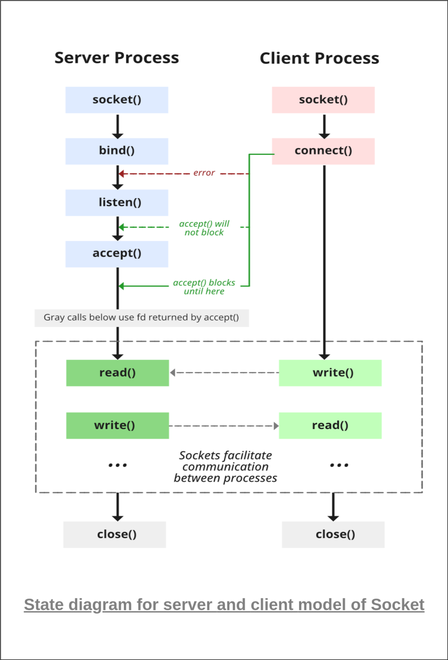Socket Programming in C
Last Updated :
09 Jan, 2024
What is Socket Programming?
Socket programming is a way of connecting two nodes on a network to communicate with each other. One socket(node) listens on a particular port at an IP, while the other socket reaches out to the other to form a connection. The server forms the listener socket while the client reaches out to the server.
State Diagram for Server and Client Model

State diagram for server and client model of Socket
Stages for Server
The server is created using the following steps:
1. Socket Creation
int sockfd = socket(domain, type, protocol)
- sockfd: socket descriptor, an integer (like a file handle)
- domain: integer, specifies communication domain. We use AF_ LOCAL as defined in the POSIX standard for communication between processes on the same host. For communicating between processes on different hosts connected by IPV4, we use AF_INET and AF_I NET 6 for processes connected by IPV6.
- type: communication type
SOCK_STREAM: TCP(reliable, connection-oriented)
SOCK_DGRAM: UDP(unreliable, connectionless)
- protocol: Protocol value for Internet Protocol(IP), which is 0. This is the same number that appears on the protocol field in the IP header of a packet.(man protocols for more details)
2. Setsockopt
This helps in manipulating options for the socket referred by the file descriptor sockfd. This is completely optional, but it helps in reuse of address and port. Prevents error such as: “address already in use”.
int setsockopt(int sockfd, int level, int optname, const void *optval, socklen_t optlen);
3. Bind
int bind(int sockfd, const struct sockaddr *addr, socklen_t addrlen);
After the creation of the socket, the bind function binds the socket to the address and port number specified in addr(custom data structure). In the example code, we bind the server to the localhost, hence we use INADDR_ANY to specify the IP address.
4. Listen
int listen(int sockfd, int backlog);
It puts the server socket in a passive mode, where it waits for the client to approach the server to make a connection. The backlog, defines the maximum length to which the queue of pending connections for sockfd may grow. If a connection request arrives when the queue is full, the client may receive an error with an indication of ECONNREFUSED.
5. Accept
int new_socket= accept(int sockfd, struct sockaddr *addr, socklen_t *addrlen);
It extracts the first connection request on the queue of pending connections for the listening socket, sockfd, creates a new connected socket, and returns a new file descriptor referring to that socket. At this point, the connection is established between client and server, and they are ready to transfer data.
Stages for Client
1. Socket connection: Exactly the same as that of server’s socket creation
2. Connect: The connect() system call connects the socket referred to by the file descriptor sockfd to the address specified by addr. Server’s address and port is specified in addr.
int connect(int sockfd, const struct sockaddr *addr, socklen_t addrlen);
Implementation
Here we are exchanging one hello message between server and client to demonstrate the client/server model.
C Program to Create Server
Server.c
C
#include <netinet/in.h>
#include <stdio.h>
#include <stdlib.h>
#include <string.h>
#include <sys/socket.h>
#include <unistd.h>
#define PORT 8080
int main(int argc, char const* argv[])
{
int server_fd, new_socket;
ssize_t valread;
struct sockaddr_in address;
int opt = 1;
socklen_t addrlen = sizeof(address);
char buffer[1024] = { 0 };
char* hello = "Hello from server";
if ((server_fd = socket(AF_INET, SOCK_STREAM, 0)) < 0) {
perror("socket failed");
exit(EXIT_FAILURE);
}
if (setsockopt(server_fd, SOL_SOCKET,
SO_REUSEADDR | SO_REUSEPORT, &opt,
sizeof(opt))) {
perror("setsockopt");
exit(EXIT_FAILURE);
}
address.sin_family = AF_INET;
address.sin_addr.s_addr = INADDR_ANY;
address.sin_port = htons(PORT);
if (bind(server_fd, (struct sockaddr*)&address,
sizeof(address))
< 0) {
perror("bind failed");
exit(EXIT_FAILURE);
}
if (listen(server_fd, 3) < 0) {
perror("listen");
exit(EXIT_FAILURE);
}
if ((new_socket
= accept(server_fd, (struct sockaddr*)&address,
&addrlen))
< 0) {
perror("accept");
exit(EXIT_FAILURE);
}
valread = read(new_socket, buffer,
1024 - 1);
printf("%s\n", buffer);
send(new_socket, hello, strlen(hello), 0);
printf("Hello message sent\n");
close(new_socket);
close(server_fd);
return 0;
}
|
C Program to Create Client
client.c
C
#include <arpa/inet.h>
#include <stdio.h>
#include <string.h>
#include <sys/socket.h>
#include <unistd.h>
#define PORT 8080
int main(int argc, char const* argv[])
{
int status, valread, client_fd;
struct sockaddr_in serv_addr;
char* hello = "Hello from client";
char buffer[1024] = { 0 };
if ((client_fd = socket(AF_INET, SOCK_STREAM, 0)) < 0) {
printf("\n Socket creation error \n");
return -1;
}
serv_addr.sin_family = AF_INET;
serv_addr.sin_port = htons(PORT);
if (inet_pton(AF_INET, "127.0.0.1", &serv_addr.sin_addr)
<= 0) {
printf(
"\nInvalid address/ Address not supported \n");
return -1;
}
if ((status
= connect(client_fd, (struct sockaddr*)&serv_addr,
sizeof(serv_addr)))
< 0) {
printf("\nConnection Failed \n");
return -1;
}
send(client_fd, hello, strlen(hello), 0);
printf("Hello message sent\n");
valread = read(client_fd, buffer,
1024 - 1);
printf("%s\n", buffer);
close(client_fd);
return 0;
}
|
Output
Client:Hello message sent
Hello from server
Server:Hello from client
Hello message sent
Compiling
gcc client.c -o client
gcc server.c -o server
Next: Socket Programming in C/C++: Handling multiple clients on server without multi threading
If you like GeeksforGeeks and would like to contribute, you can also write an article using write.geeksforgeeks.org or mail your article to review-team@geeksforgeeks.org. See your article appearing on the GeeksforGeeks main page and help other Geeks.
Please write comments if you find anything incorrect, or you want to share more information about the topic discussed above.
Share your thoughts in the comments
Please Login to comment...